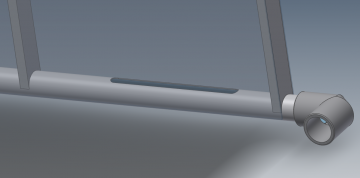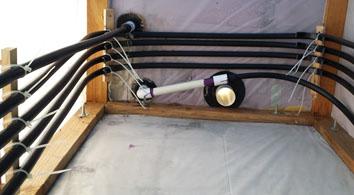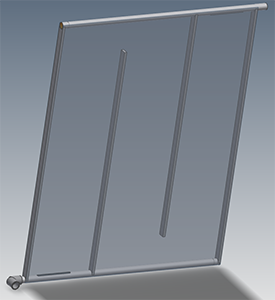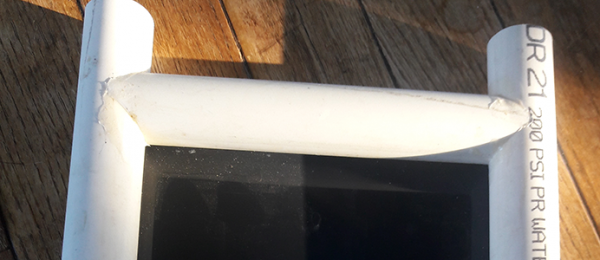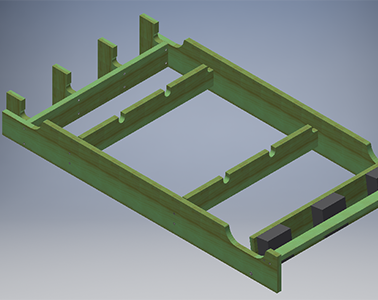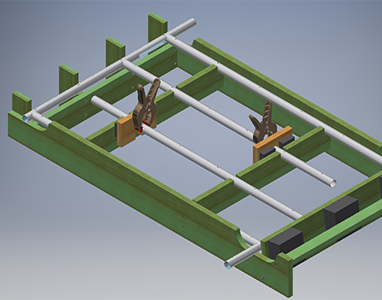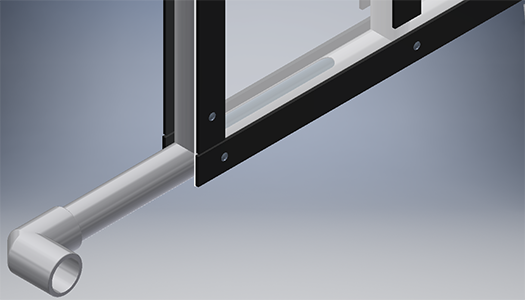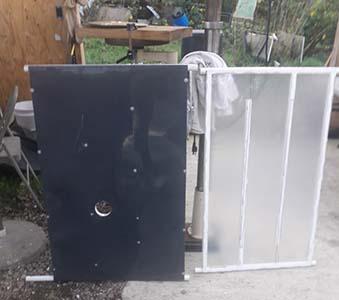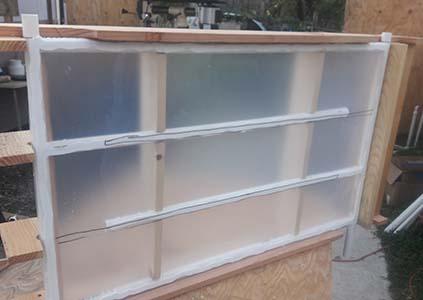Location
The saga of [The_Cube]
[All images are ‘clickable’]
I have decided to begin blogging about the development of [The_Cube] (one of the first— in fact AFAIK, the world’sonly— kittable, shippable, insulated, heatable, small biogas digesters), as one of the things I will be doing to bring information about it to others. This is my first such blog: wish me luck. Or send money.
I might as well start by saying that I call it [The_Cube] because the name itself, at least written within square brackets, is sort of cubic, and, no surprise, so is the digester. That is, because this digester is made according to the dimensions of common materials, such as plywood, the base is 4'x6', i.e. nearly the full size of a single sheet of plywood; and everything else derives from that. [The_Cube] sits on one side of the plywood and lumber base, and of course you can surmise, based on its name, that [The_Cube] is 4' wide, 4' long, and 4' high. Sort of… cubic…
Biogas is situational. Does it make sense to provide generic designs?
The main idea behind [The_Cube] was to see if it was possible to create a detailed, practical, easily-built, low-cost, scientifically-based design for a biogas digester that might serve in many situations.
Why not 20 years ago? Well, when I first wrote The Complete Biogas Handbook, my research convinced me that biogas was highly situational— some have a great deal of a substrate, others have very little; some have substrates with very specific requirements (such as manure that comes mixed with a lot of water, or with a lot of sand), others have substrates which digest easily and provide few additional challenges; and so on.
Of course, all forms of energy available for human use are situational: you can’t use electricity in the deep bush, because the extension cords aren’t long enough; you can’t use solar in a cave; you can’t use hydro in the desert; and you can’t use wind power in a dead calm.
But in any case, these different situations require different designs, so the Handbook is written to enable anyone who reads and heeds to design a digester that would suit their own unique circumstances. And the key point is that when I wrote the book, I was not sure that it made sense to do much more than offer suggestions about designs, and after that, everyone would have to design their own, or hire someone to design it.
The thing that caused me to finally choose to pursue making a US-capable biogas digester design was, in large part, the change in my own situation. I’m getting older, and as compared with how long I’ve lived to this point, the time ahead is short. I’ve raised my children and they don’t need me anymore, or at least not in a any crucial way. I love my wife deeply— she is my best friend, my love letter from Bahá’u’lláh— but we do not need to be together 24/7. I no longer have nor need a full-time, punch-the-clock job. So choice beckons: Learn golf? Watch more TV? Try to find a bar like Cheers? Post a dreary string of angrier and angrier messages to fewer and fewer Facebook groups?
Uh… thanks. Have a good day. I’ll pass.
What I have decided to pursue, as long as I am able to walk around on my own two sticks, is to go out into the world and help the poor. If you know anything about me you know that I have plans for that effort, but I won’t go into any detail about that just now. The point is that if I want to help the poor, I need resources, and while the great need is over there, the money is here. So to create a megaphone, to bring attention, to have something that folks can point cameras at while pointing a microphone at me while asking pointless questions, I decided in April 2014 while getting ready for a Biogas Workshop in Brooklyn that a necessary step is to create a digester that might excite enough folks to allow me to check that box: Got the modest funds I need, check. Meanwhile as well, the US and the world gets a digester that might have some considerable benefits. Win:win, maybe?
- 95°F/35°C: 100%
- 85°F/30°C: 68%
- 75°F/24°C: 46%
- 65°F/18°C: 32%
- 55°F/13°C: 21%
- Colder than 55°F?:
zero, nada, nil
Get afree XLSto compute biogas production at diff. temperatures
To have a heated digester, you have to heat it
So where does one start? Well, the core, foundation and most important thing is that practical biogas in the US requires heated digesters. Period. No exceptions. (Well… maybe we should make an exception for large, underground digesters, but only maybe.)
That’s because the rate of biogas digestion/production is determined by the temperature of the slurry. And the climate in all 50 states in the US is, quite simply and quite factually, too cold (although in the warmest US areas, only during the winter) to support constant digestion, much less year-‘round, high-rate digestion. (See these Mother Earth News blogs—one and two— for more complete information. You can find all of my MEN blog posts linked from this page.)
First draft: pipe coil
So, is it possible to design a practical biogas digester that made from common materials? Can one be made that is low-cost, easy to build, robust and scientifically-based?
In my first attempt at a digester design that would fit those parameters, I was trying to do heating by using a flexible black poly pipe coil. The digester was a press-plastic type, which I don’t want to take the time to explain here. This digester was 4'x4'x8', and the poly had room to be bent around the inside corners without kinking, as you can see.
But of course ideas per se are not sufficient. This is the day and age of science, and besides imagination and casual experimentation, we have to use scientific tools, such as mathematics, to test the validity of our ideas. Here on the Left Coast, we use math to make decisions about such things. Want to see?
Well, regardless, I’m not going to show you the math, not here at least. Most of you probably don’t care a whole flaming lot about the physics and math of heat loss, so we’re good, yeah? But for those who, like me, geek out on that stuff, I am providing a link to the XLS I used to determine the best type of pipe to use, and to gain an idea of the core metric of interest, which is dollars required for a given outcome. My conclusion on the basis of that fairly extensive XLS, using pipe prices in my area at the time of calculation, data about rates of heat transmission through various kinds of pipe, and standard formulas for heat loss in pipes, was that flexible black poly gave the most bang for the buck.
Update 2021/04/12: I have just found a copy of “Numerical study of heat transfer performance of helical coiled tubes for heating high-solids slurry in household biogas digester” (here), which says that‘The difference in the rates of total thermal resistance between cross-linked polyethylene (PEX) and metal (stainless steel and copper) coiled tubes was small for the high-solids fermentation slurry compared to that for the water.” [emphasis added]
The fact that the slurry used in that study had such an impact on the efficiency of heat transfer through the materials mentioned is, in my opinion, pretty amazing. I note that the spreadsheet assumes the heat transfer values offered by research done using mere water, not beautiful slurry, so please take the numbers in my spreadsheet as relatively correct, but not certainly and absolutely correct.
I learned a lot from this digester, including that I would need far better plans if others were to build any design I came up with. (That’s why I got Autodesk Inventor and taught myself how to use it. Marvelous software. It’s opened a new universe to me, because for the first time, I can communicate design ideas with clarity, precision and beauty.)
I continued experimenting and thinking, and Jeff Ironwood-Hunt and I started doing materials tests, to find out what glues and caulks would work to cement which materials to specific other materials. We did dozens of tests, recording our results. (Thank you again for all your hard work, Jeff.) One key thing we discovered was that rigid polystyrene insulation (the pink stuff) can be welded to itself using any of several caulks, or using spray foam urethane. This was a tremendously exciting discovery for me. As soon as I saw how strong the weld was, I instantly knew this had to be the foundation of my next design: “The insulation is the container”
It was clear that this was the road forward, so I changed to designing one specific example of what I refer to as “poly-panel” digesters. (Read more about “poly-panel” digesters here.)
As the ideas about this new digester design developed, in addition to having inlet and outlet pipes in opposite corners, I added a kind of water wheel system for agitation in the middle. As such, not only was this digester smaller, but it was also more complex inside than anything I had previously attempted. I became more concerned about space than I had ever been— about getting things properly packed in— and therefore much more concerned about where things inside were going to be, exactly. It would not do to have something tangling up in the water-wheel agitator, would it? As such, I realized that in order for me to use a coil for heating, I would have to turn the corners by using elbows; there was not enough room to make a proper bend in the poly, without complex heating and bending processes.
Now poly pipe elbows are not very expensive, but making a one full turn of a coil, a single complete circuit, requires four. I needed as many turns of pipe inside as I could fit, in order to increase the surface area available for heat transmission to the slurry. Twenty loops would take 80 elbows. It all adds up. As I evaluated the mounting costs and similar problems, I began to consider whether there were other alternatives.
HEx units, version zed
What came to me was the idea of using “all-PVC” panels:
- 3/4" class 200 (thin-wall) PVC pipes, at the top and bottom for inlet and outlet;
- 3/8" flat PVC sheets cut for side walls and channel separators; and
- 1/16" PVC sheets, front and back, to contain the water.
As seen below, the bottom pipe is PVC, the gray sidewalls connecting the pipes are PVC (3/8"), and the heat exchange surface (translucent gray) covering both pipe and sidewall is PVC. Becauseeverythingis PVC, it can all be glued together with standard pipe glue. Cool, right? These are “heat exchange” panels, so I call them “HEx” panels.
Hotter water flows into one of the pipes (bottom or top, depending, but as seen just above, into the bottom), where one end of that pipe is connected to the hot water source or to another HEx panel, and the other end is blocked. The pipe has a slot routed into it (as you can see above), and since that is the only outlet, the hotter water flows through that slot into the first space between the thin PVC sheets, which in the pictures above are rendered as being mostly transparent. (The actual sheets are opaque and gray, which is usually the cheapest color.) The hotter water continues to flow in, filling a third of the HEx panel. Its heat is released to the slurry through the 1/16" sheet and so it cools down some. After filling the first chamber, the water then spills over the separator and flows into the next area (where it again releases heat to the slurry, cooling more), and from there up into the third section, filling that one too. Then it flows out through a slot in the top (outlet) pipe which is opposite the slot in the inlet pipe. That top outlet pipe is also blocked on the end opposite the inlet pipe.
I was pretty jazzed about this design. To me, for a long time anyway, it seemed elegant, simple, beautiful. And the feeling was improved when I did the math and found out that it was twice as efficient and half the cost of the coil option, at least as designed by me and described above.
Reality is not subject to popular vote
But after I finally got to make the parts and I built several sets of these, I began to think that these HEx panels were more expensive than they needed to be. The pipe was cheap, at 17¢/ft, but the 3/8" PVC was expensive, particularly because I could not purchase exactly what I needed: I had to buy a whole 4'x8' sheet, at $240, ~$7.50 per ft2. (Ouch!)
The cost of the thin sheets was likewise pretty steep, @$50 per 4'x8' sheet, and again I had to purchase entire sheets to get the pieces I needed. Depending on the specifics of the implementation (like the exact size of the HEx panels) and the amount of waste experienced, that meant that one HEx unit might cost $33; or it could be much more. Four of them, therefore, approached $150, again depending. And just as importantly, given that this design was intended to be DiY, how would those who wanted to build it afford to make HEx units, if they had to purchase complete sheets of 3/8" and 1/16" PVC? If others also were required by their local plastics outlet to purchase full sheets, then adding in the leftover plastic, the cost of the 4 HEx units needed for a complete assembly climbs dramatically, maybe even to something above $300. Not good. And certainly not “low-cost”.
That was brought home to me very painfully when I left several sheets out in the sun in the back of my pickup while I went back inside and took care of some last-minute details before taking them to be cut. When I got back outside, to my horror, everything— hundreds of dollars worth of sheet plastic— had been warped by the hot sun and was rendered completely unusable.
As well, when testing the units for water tightness, I found that it was nearly impossible to eliminate the little and bigger leaks that seemed to blossom in various spots just under the thin face sheets. For me it was whack-a-mole, finding, re-gluing and re-testing. How would others deal with that issue?
Further, in order to find those leaks, I had to fill the HEx units with water. It was surprising and a little alarming (when I stood the units upright) how much the facing sheets bowed out on the bottom from the pressure of the water. Fix that! So I began to put screws into the facing sheets, attaching them more securely to the pipes and the 3/8" PVC.
More work, more parts, more time, more testing, more repairs, more complexity.
No longer elegant.
(Just by the way, such units do not experience water pressure stress inside a digester in actual use, since they are surrounded by liquid, and filled with liquid: No pressure differential, no stresses.)
Then too, the design required a lot of glue. The glue was liquidy: good for putting fittings on pipe, but not so good for laying down a bead along the top of small diameter pipe and then securely gluing thin PVC sheets.
And the 1/16" sheets to some degreeretardedheat exchange. This is because because facing sheets that are thicker provide slower (less) heat exchange. Sheets that are 1/8" would be half as efficient; sheets that are 1/32" would be twice as efficient. (Purchased as PVC sheets, 1/32" is also much more expensive and difficult to find.)
So, yeah. Some things seemed right about this approach, but others, not so much, and as I marched forward, it seemed like more and more about them were falling into the “'not so much” category.
On balance, the design was easy to make, but it was difficult to make it well; and it was expensive. There were too many problems.
So whereas I had started by practically breaking my arm patting myself on the back and being wonder-struck at how clever I was (or at least how clever my muse was), reality began to set in, like it always seems to... at least for the honest among us. It takes me a while to figure things out, but I hope that most of the time, eventually I do. (My wife might disagree, so don’t ask her. My children are more certain to disagree, so don’t even think about asking them. I have the thin tatters of my reputation to conserve. Sniff!)
Naturally after the full measure of my dissatisfaction set in, I began to hope for better inspiration in terms of design. (My best ideas seem to come to me when I’m praying...) Maybe there was an even better design lurking somewhere in the cosmos, waiting to waft past and get tangled up and caught in my sub-conscious neurons. Hello? Anybody out there?
Hey... pipe for the sidewalls?
I got to part of the answer when I realized— duh— I could replace the 3/8" PVC sidewalls and separators with 3/4" class 200 pipe (hey yeah!), which of course is far cheaper and far easier to find (at least on the West coast). I built some test units, and proved the concept:
The key big deal is that you have to put a half cylinder hole in the end of the pipe, as you may be able to see or intuit from the picture above. And that’s not hard, as it turns out. (I’ll probably tell you how, some other time. But meanwhile, back at the ranch….)
With this new pipe-as-sidewall idea, I had to develop a better jig to make the new, never-before-built all-pipe HEx frameworks:
Again: Autodesk Inventor! (I color all the wood in my jig images green so the jig lumber is easy to identify as being different than the wood or other materials they are holding in place.)
All the slots and indentations in the jig hold the pipes in their relative positions (as you may be able to see), and the foam pads nearest to us compress the outside pipes and the top and bottom pipes together. The separator pipes are held in place by squishy foam and hand clamps, again as you can see. (Glue it all up and let it set for a bit.)
...And the facing material?
With that much done— I had completely replaced the 3/8" PVC!— I walked around muttering to myself, meditating on the question of how to replace the relatively expensive, relatively thick, rigid 1/16" PVC sheets with something thinner, and more flexible, and for heaven’s sake cheaper.
The problem I foresaw had to do with the fact that most plastics are very difficult to glue together. It's near impossible to glue polyethylene to itself or anything else, for example, and many other kinds of plastic can only be glued to another bit of the same material, depending on the glue used. Some plastics are best put together by being heat welded... (But that's a story for another blog: one about gas storage.) In any case, this was the core reason that I had been so happy about the “all-PVC” HEx panels idea: I thought I was making an end-run around the Big Problem With Plastics.
Yet the more I thought about it, the more it seemed to me that I might actually be able to use almost any kind of fairly thin flexible plastic sheets, attaching them to my PVC pipe HEx panel framework with rivets holding 1" strips of thicker (cheap) plastic (of whatever kind) which would help hold the sheets on. And maybe also I would have to use weatherstripping to improve the seal…. Probably?
I thought it might work. Maybe. Possibly. Fingers crossed. Turn around three times and bay at the moon. (Then it will work.)
After mulling the situation over for a couple of weeks and making some design variations in Autodesk Inventor (a beauty of a program, right?), after looking at options for rivets, purchase and testing of two riveting tools, purchase and testing of several kinds of weatherstripping, and so on, I wandered into a store (TAP Plastics, in Tigard, OR) with my son, and we bought some 2'x4' sheets of polypropylene,1/32" thick, at $4 ea. At the time, I paid no attention to what kind of plastic it was, in fact. (But I knew that if it worked, it would be far better than the $12-$13 for a similar sized sheet of thin PVC, right? And half as thick as well, so twice as good for heat transfer.)
Then I built a HEx framework using the new jig. That worked really well, and taught me about some minor adjustments that I would have to make.
And then I prepared to put on the weatherstripping, some sort of caulk, the 1" strips, the holes, the rivets, all in several variations and permutations…. Take a deep breath and begin?
Living in a materials world
But wait. The real problem was the same problem that had caused Jeff Ironwood-Hunt and I to do materials tests in the first place. That is, we had some very specific materials to put together, and very little specific information about what sorts of caulks or glues might best bind them together. I needed to do more materials testing.
So I did.
What I found out amazed and delighted me. It turns out that DAP 3.0, Kitchen, Bath & Plumbing caulk bonds strongly to both PVC and polypropylene. It has really good adhesion to both materials, and it is very hard to peel off! So it turns out that nothing is needed except the class 200 pipe, the polypro sheets, the standard PVC pipe glue, and the jig, and anyone should be able to build this new HEx panel design.
No plastic strips. No weatherstripping. No drilling holes and putting in blind rivets. The beauty of simplicity. Back to elegant! After all the worry and muttering and testing and hope,… elation!
And the cost? On the same cost basis that I reported above for the “all-PVC” HEx panels, @$33, these panels cost $10, a third the cost, and they are approximately twice as efficient at heat transfer as the “all-PVC” HEx panels.
Maybe next week another good thought will come, and we can make further dramatic improvements, no? Turn around three times and bay at the moon. Then it might happen.
[Late note: Indeed, I have discovered another improvement that can be made to this design: But that’s another blog post, yes? Meanwhile, I’l keep praying for better ideas...]

